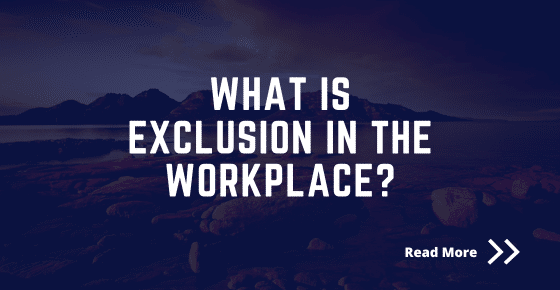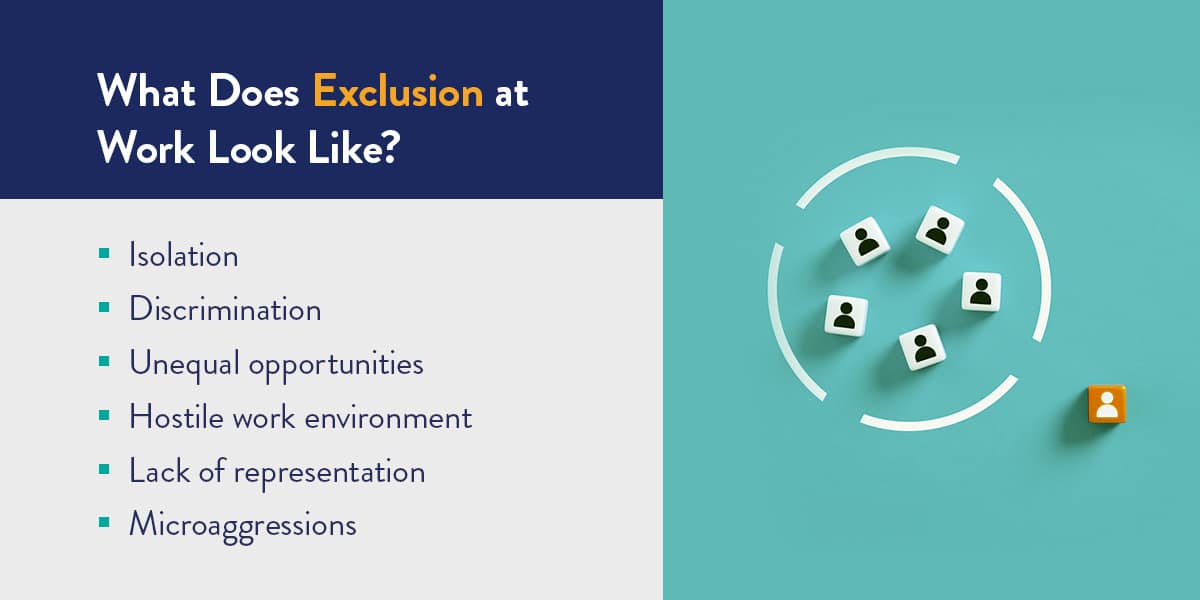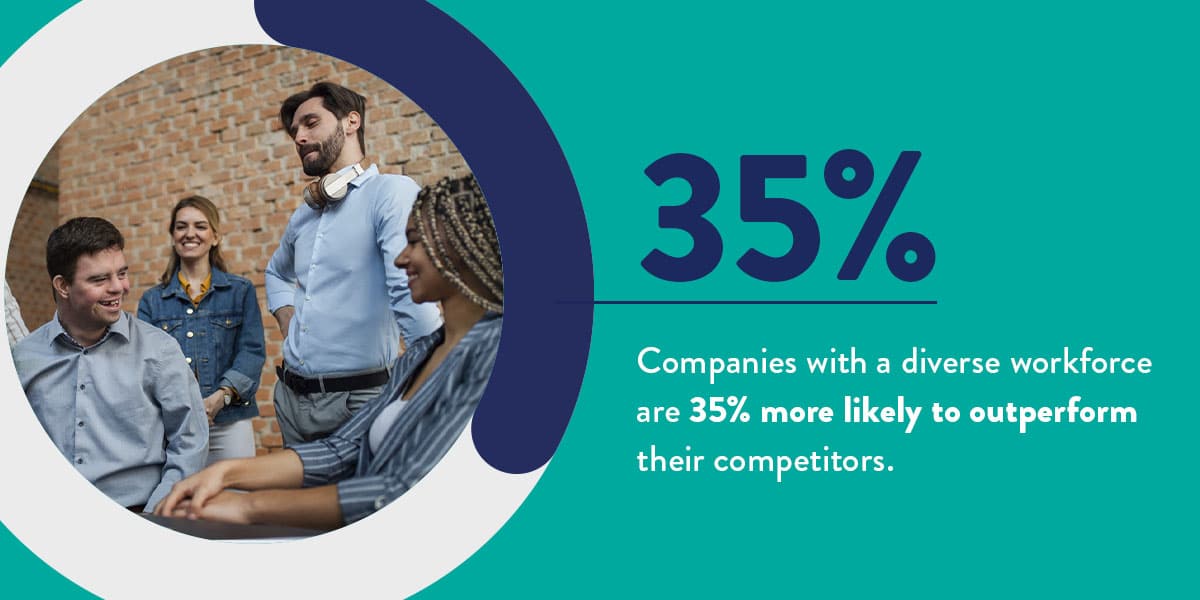DEI, Equity and Inclusion, Uncategorized
What Is Exclusion in the Workplace?

Rumors, gossip and tensions are intangible elements that affect productivity and cost the business. Human Resources (HR) professionals, managers and executives can take steps to prevent exclusionary behaviors and create an inclusive workspace.
- What Does Exclusion at Work Look Like?
- What Are Some Examples of Workplace Exclusion?
- What Is the Impact of Workplace Exclusion?
- Why Is It Important to Prevent Exclusion?
- What Can Management Do to Prevent and Handle Exclusion?
- Create an Inclusive Work Environment With Exude Human Capital
What Does Exclusion at Work Look Like?
Exclusion in the workplace is what occurs when certain employees are marginalized or mistreated, either intentionally or unintentionally. It comprises different forms of discrimination and bias.
It usually results in unequal treatment of employees based on race, age, sexual orientation, religion, gender or other factors.
Exclusion manifests in several ways that create a toxic work environment with microtensions leading to a hostile atmosphere. Understanding exclusion in the workplace is critical to being able to identify it. Here are the common types:

- Isolation: Excluding certain employees from meaningful discussions, social events or meetings may leave them feeling isolated from essential interactions.
- Discrimination: Treating someone unfairly based on personal characteristics and making biased decisions about compensation, promotion or hiring.
- Unequal opportunities: Offering particular groups or individuals fewer opportunities for development, advancement or growth according to personal characteristics.
- Hostile work environment: Creating a space that doesn’t address bullying, discrimination or harassment.
- Lack of representation: Establishing inadequate representation of certain groups in decision-making and leadership roles.
- Microaggressions: Making employees feel uncomfortable or unwelcome through subtle or unintentional comments or acts portraying biases or stereotypes.
What Are Some Examples of Workplace Exclusion?
Workplace exclusion makes individuals feel isolated and othered. Feeling excluded affects employees’ efforts in the workplace, which influences output. Here are some examples of what workplace exclusion looks like:
Social Exclusion
Exclusion is a form of bullying in the workplace that has adverse effects on victims’ mental health. The typical scenario is a group of employees ignoring or not engaging with a particular employee.
You’ll commonly spot this behavior in shared areas like breakrooms. These rest areas are crucial for employees to get a break and engage with others. With social exclusion, employees may feel excluded from the chit-chat. It makes them feel demotivated when they return to their work.
Sometimes, social exclusion is not on purpose. Employees may be involved in their own plans and not notice the individual sitting alone. However, social ostracism is a form of workplace bullying because individuals purposefully ignore certain colleagues.
Condescension
If an employee constantly criticizes and belittles another co-worker’s ideas or comments, that’s a form of exclusion. The victim may feel inferior and discouraged from sharing their thoughts in the future.
Condescension is also a way that egocentric managers manipulate employees into submission. Human resources should keep track of these patterns of behavior. There’s a fine line between providing constructive criticism and singling out an individual to belittle them.
Mobbing
When a group of employees get together to target a specific individual, this is known as mobbing. It’s a common form of exclusion because it makes perpetrators feel more courage as they have the support of a group. They may engage in humiliation rituals, criticism and other cruel acts to make the individual feel insecure and pressure them to leave the company.
There are three main types of mobbing that frequent negative workspaces:
- Physical mobbing: Initiations, hazing and sexual harassment are forms of physical mobbing. It could also refer to destroying an individual’s property, pushing them around in the parking lot or shoving them out of the way. Physical mobbing intrudes on the victim’s personal space and aims to destroy their dignity.
- Verbal mobbing: Vicious workplace gossip, hurtful or offensive remarks and manipulative comments are examples of verbal mobbing. The perpetrators seek to embarrass the victim through verbal abuse. The perpetrators may also make biased or stereotypical remarks and pass them off as a joke.
- Social mobbing: Social platforms create a space that makes bullies feel safe while engaging in mobbing techniques. Cyberbullying that occurs outside the workplace can drastically affect productivity and attitudes in the work atmosphere. Social mobbing seeks to isolate, make fun of or spread rumors about an individual.
Serial Bullying
Serial bullies target several victims and move from one to the other quickly. They can make their target feel burned out, depressed and frustrated.
Executives and HR managers should watch out for this type of individual. They usually commit offenses that are shrouded in doubt. They also project their actions onto others and distract attention away from them. Here are some of the characteristics to check for:
- Lies compulsively and convincingly
- Destroys company reputation
- Reacts to criticism with victim blaming and denial
- Appears to be immune to disciplinary action
- Causes victims to feel high levels of stress and fear
- Moves on to a new victim when their previous one quits or burns out
What Is the Impact of Workplace Exclusion?
The average person spends approximately 2,080 hours at work, so the workplace environment and interactions can significantly impact mental health. Exclusion can cause high stress levels and create negative associations with the workplace.
Workplace exclusion affects multiple facets of a business, from employee mental health to customer service.
Employee Mental Health
Exclusion makes employees feel lonely and unaccepted in the workplace. It raises their stress level and contributes to mental health issues like depression and anxiety.
Mental health conditions can also manifest into physical symptoms, including headaches. These symptoms could lead to more sick days, costing the company.
Reduced Productivity
An inclusive culture prevents burnout and increases efficiency. Exclusion leads to lower morale, which negatively affects productivity.
Employees might find it challenging to focus on their work when they’re anxious or afraid of being bullied.
Low Retention Rate
Exclusion in the workplace can push targeted employees to quit, especially if no measures are in place to protect them. Often, the perpetrators do everything they can to get the victim to leave.
A low retention rate costs the company more for recruitment and prohibits company loyalty.
Workplace Exclusion Lawsuit
If employees feel excluded, especially at the hands of management, they can file a discrimination claim. Protected classes can also claim for discrimination even if the exclusion was unintentional.
For example, if women aren’t invited to a golf trip with the CEO, it could disadvantage them in future promotions. They wouldn’t have the same advantages in building a connection with the CEO, so it’s a corporate practice that disadvantages members of a protected class. This type of scenario could form the basis for a workplace exclusion lawsuit.
Company Reputation
Whether through a lawsuit or word of mouth, exclusion can ruin a company’s reputation. It prevents individuals from the affected protected groups from seeking employment with that establishment.
Rumors could also travel and turn potential customers away from investing in the business or wanting to be associated with the brand.
Why Is It Important to Prevent Exclusion?
Exclusion in the workplace has a negative ripple effect throughout the company. Focusing on inclusion and diversity leads to higher employee engagement and stronger connections with clients. Here are some of the benefits of taking measures to prevent exclusion and promote inclusivity instead:
Promotes Diversity
Preventing exclusion focuses on inclusivity, promotes diversity and creates a safe space for protected groups. The company will benefit from different outlooks and unique perspectives.
People from different backgrounds, cultures and lifestyles can ultimately drive innovation within the organization. Companies with a diverse workforce are 35% more likely to outperform their competitors.

Improves Morale
A positive company morale can lead to better job satisfaction and increased self-esteem. Promoting inclusivity allows all employees to shine and feel happy and safe at work.
By boosting morale, employees will also have an improved mental state. It enhances creativity and aids teamwork.
Boosts Productivity
When employees feel like they belong and are equally valued by the company, they work better together. With antiexclusion practices in place, individuals will work hard to show their appreciation for fellow colleagues.
When workers get along well, productivity increases, which benefits the company in the long run.
Lowers Retention Costs
When excluded, employees often quit, leading to higher turnover costs. Recruitment and training can add up if companies have to hire a significant number of employees annually.
By preventing exclusion and focusing on inclusivity, companies can retain their already trained staff members. They can also invest more time and resources into upskilling those employees to perform more advanced tasks.
Attracts Top Talent
While exclusion may turn potential employees away, inclusivity does the opposite. As word of the company’s inclusive environment spreads, top talent will want to join.
People seek companies where they feel valued, and it doesn’t just attract them — it keeps them. Top talent looking for a company to plant their roots in will be more attracted to an inclusive organization that focuses on giving employees a fun, fair and rewarding environment.
Reduced Legal Risks
Whether intentional or unintentional, workplace exclusion can result in certain legal liabilities like reputational damage. These legal risks paint the company with a negative hue.
Promoting inclusivity helps the company maintain a positive public image. It reduces the chances of legal risks like exclusion lawsuits because it focuses on treating all employees equally.
Drives Customer and Client Relations
An inclusive workplace culture creates happy employees, which impacts customer relations. Giving all employees equal space to grow and shine can improve their self-confidence and moods. It shows when they speak to customers.
What Can Management Do to Prevent and Handle Exclusion?
Management and HR should be at the core of preventing and handling exclusion in the workplace. You should know how to deal with exclusion in the workplace effectively and without adding tension.
Here are the top methods to prevent and handle exclusion in the work environment:
Engage in Open Communication
Create a culture where everyone feels comfortable sharing their ideas and thoughts — as long as they aren’t offensive. Encourage individuals to share their hobbies, interests and events.
Facilitate spaces where the team can engage with each other, like catch-up meetings. It creates a platform for employees to get to know each other and communicate without potentially loaded topics like politics.
Create an Inclusive Office Layout

An open and inclusive office layout can make people feel less alone and prevent clique formation. Activities like Jenga or a snack board can keep them engaged and encourage positive socialization.
Ensure the common areas also include spaces for people who prefer taking some alone time on their breaks. You could include a meditation area or quiet zone for those who prefer less social stimulation.
Focus on Positive Engagement
Make a conscious effort to create positive engagements within the team. Build a culture of showing gratitude toward each other and recognizing the work every team member does to help the company reach its mission.
At the end of a meeting, request feedback from every team member to make everyone feel valued and provide a platform for all employees to share their ideas without judgment.
Build Stronger Connections
While not everyone wants to form friendships at work, stronger connections are still crucial among colleagues. They boost productivity, teamwork and mutual respect.
An occasional team lunch is an excellent way to build stronger connections. It creates an inclusive space where people work to include instead of exclude others.
Practice Empathetic Leadership
Empathetic leaders seek to attain a deep understanding of their employees’ needs and experiences in the workplace. A pivotal part of this leadership style is listening actively. When a victim or perpetrator of exclusion comes forward, listen to understand. It takes a lot of courage to speak up, so you must create a safe space for them to open up.
This leadership style can also prevent exclusion because victims have a space to speak freely, which could deter negative behaviors.
Take Immediate Action
In most cases, especially when malicious acts of exclusion haven’t occurred, perpetrators or victims might speak up. You might even notice the tensions rising through observation.
It’s essential to take immediate action to resolve any tensions between both parties. Have a conflict management strategy in place to prevent things from getting worse and help team members who may clash work together peacefully.
Offer Diversity and Inclusion Training
Companies should invest in inclusivity training that focuses on teaching leaders to create empathetic and positive environments. These programs can also help raise awareness of exclusionary behaviors and stereotypes and uncover unconscious biases.
Leadership development programs should also include inclusion training. Leaders can lead by example in creating a positive, inclusive environment and pointing out any exclusionary behaviors that may cause tensions down the line.
Set Strict Antidiscrimination Policies
Develop clear antidiscrimination policies and communicate them effectively with employees. It should explicitly prohibit exclusionary behaviors, harassment and bias.
These policies will deter perpetrators from acting on their biases or bullying behaviors. It will also create a safe environment for protected groups by letting them know the company is working to create an inclusive environment.
Create an Inclusive Work Environment With Exude Human Capital

Exploring inclusive environment practices starts with reaching out for help. At Exude Human Capital, we specialize in equipping business leaders with practical solutions to help their employees and companies thrive. If you work with us, we’ll invest our time and resources into creating an environment that’s streamlined, tension-free and keeps every employee working happily toward the company’s vision.
Our team of consulting experts in diversity, equity and inclusion offers a holistic view of inclusivity and productivity. Feel free to contact us for a complimentary 30-minute consultation, and let us build a formula for your company’s success.







